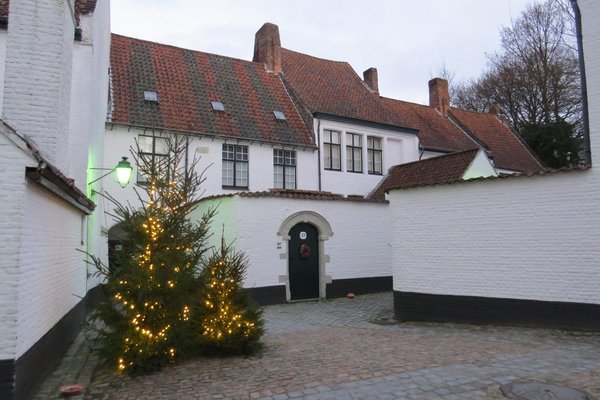Belgium
Flemish Béguinages
The Flemish Béguinages are secluded compounds made by a medieval religious movement.
The Beguines were women who entered into a life dedicated to God without retiring from the world. They founded the béguinages, communities enclosed by walls or ditches that opened their gates during the day. The béguinages held houses, churches, public buildings and gardens to serve their spiritual and material needs.
Community Perspective: these 13 béguinages all are fairly similar and there are many more in the Low Lands than those inscribed. Recommended are the large Groot Begijnhof of Leuven, the secluded beguinage of Kortrijk and the béguinage of Brugge. A visit can easily be combined with the Belfries WHS, as most Flemish towns with a belfry also have a béguinage.
Site Info
Official Information
- Full Name
- Flemish Béguinages (ID: 855)
- Country
- Belgium
- Status
-
Inscribed 1998
Site history
History of Flemish Béguinages
- 1998: Inscribed
- Inscribed
- Type
- Cultural
- Criteria
- ii
- iii
- iv
Links
- UNESCO
- whc.unesco.org
- Official
-
- toerisme.mechelen.be — Mechelen
- visitleuven.be — Leuven
All Links
UNESCO.org
- whc.unesco.org — whc.unesco.org/
Official Website
- toerisme.mechelen.be — Mechelen
- visitleuven.be — Leuven
News Article
- Dec. 27, 2013 deredactie.be — 1.3 million EUR for renovation Beguinage in Ghent
- April 15, 2013 hbvl.be — Last Beguine has died in Kortrijk
Community Information
- Community Category
- Religious structure: Christian
Travel Information
Exact locations inscribed twice (or more)
Recent Connections
-
Perfect Inscriptions
1998 -
Vernacular architecture
The "architectural form [of the buildin… -
Timber framing
The Grand Béguinage of Louvain and, to …
Connections of Flemish Béguinages
- Geography
-
-
Scheldt
Beguinage of Dendermonde: close to the Oude Dender (a river in the Scheldt drainage basin) and some 900m from the Scheldt proper
-
- Trivia
-
-
Opera
Die Tote Stadt, Korngold -
WHS within walking distance
Walk from Brugge city center -
Viewable from another WHS
The Beguinage of Mechelen can be seen from the St. Romboutstoren (one of the Belfry WHS), the Beguinage of Bruges is visible from its Belfry as well -
Role of Women
"The béguinages bear exceptional witness to the cultural tradition of independent religious women in north-western Europe in the Middle Ages." -
Tour de France
Tour de France 2015, Stage 3 (Lier beguinage) -
Depicted in Mizielinska Maps
Our-Lady Ter HooyenSee i.pinimg.com
-
- History
-
-
Popes
One of the pastors of the Béguinage of Leuven, in 1490, was Adriaan Florensz. Boeyens of Utrecht, spiritual advisor to the young Emperor Charles V and best known as the later Pope Adrian VI.See nl.wikipedia.org
-
- Architecture
-
-
Brick architecture
"Beguine houses are small single-storey brick buildings with a small enclosed garden." (AB Ev) -
Baroque
The "Church of Saint-Alexis and Catherine in Mechelen, a fine Baroque building by J Franquart and P Huyssens" and the "Baroque decor (Church of Saint-Jean-Baptiste in the Grand Béguinage of Leuven, Church of Sainte-Catherine in Diest, etc)" (AB Ev) – Baroque gates of the béguinages of Diest and Lier (Nomination file, p. 11) – Baroque interior of the Church of Saint-Catherine in Tongeren – Baroque churches of the Small Béguinage in Gent and of the béguinages in Lier and Hoogstraten. The church of the béguinage in Turnhout has both gothic and baroque elements. (Nomination file, p. 13) -
Garden City Movement
The very layout of the béguinages, with all the variations as well as their inventive way of integrating green spaces, gardens and "natural" plantations was seen, at the time, as a "model" and source of inspiration for the garden cities which would emerge mainly in the inter-war period. (Nomination file, p. 39) -
Gothic
Saint Catherine Church in Tongeren; Church of Saint John the Baptist in Leuven; Saint Catherine Church in Diest. The church of the béguinage in Turnhout has both gothic and baroque elements. The oldest houses in the béguinage of Bruges. (Nomination file, p. 12-13, 18)See nl.wikipedia.org
-
Gothic Revival
"The Béguinage of Mont-Saint-Amand-lez-Gand (...) was built (1873-74) as a global project adopting the traditional concepts of the béguinages and a neo-Gothic architectural style." (AB Ev) – The chapel of the Béguinage of Dendermonde (Nomination file, p. 14) -
Renaissance
A large number of Béguinage houses in Sint-Truiden date from the 17th and 18th centuries and were built in the Maasland Renaissance style.See nl.wikipedia.org
-
Rococo
The Rococo clock tower of the béguinage church of LierSee nl.wikipedia.org
-
Romanesque
The béguinage church of Saint Agnes in Sint-Truiden is a late Romanesque, early Gothic building. -
Spolia
The oldest, early Gothic church building of the Béguinage of Bruges dates back to 1245, when Countess Margaret of Constantinople had the disused chapel of the burgrave on the Burg transferred to the recently founded Beguinage Ten Wijngaerde at the request of Bishop Walter van Marvis. This transfer must be interpreted quite literally: apart from the contents (furniture, books, liturgical objects and ornaments), the building materials were apparently also reused as much as possible.See nl.wikipedia.org
-
Timber framing
The Grand Béguinage of Louvain and, to a lesser extent, those of Sint-Truiden and Turnhout still include remains of half-timbering used as underpinnings in later constructions. (Nomination file, p. 17) -
Vernacular architecture
The "architectural form [of the buildings] takes its inspiration from the traditional architecture of the region, using its materials, proportions, and forms as appropriate." "The Flemish béguinages demonstrate (...) a combination of religious and traditional architecture in styles specific to the Flemish cultural region." (AB Ev) - Beguine houses are part of urban vernacular architecture. (Nomination file, p. 18)
-
- Damaged
-
-
Damaged in World War I
Dendermonde: the Beguine church was burned down by the Germans -
Damaged in World War II
"These 13 béguinages testify to their original function, even though many suffered damage during World Wars I and II." (OUV) – The Second World War damaged the béguinages of Hoogstraten and Turnhout in 1944 and caused the destruction of a small island of the béguinage of Leuven. (Nomination file, p. 9) -
Thefts since inscription
The theft of 12 gold coins from the béguinage of Kortrijk in 2016.See vrtnws.be
-
- World Heritage Process
-
-
Perfect Inscriptions
1998 -
First inscriptions
Belgium, 1998. Actually 3 Belgian sites were inscribed that year, but the Beguinages have the lowest id and is named first in the report of that session. -
Part of Cultural nomination rejected
The inscription proposal counted 26 béguinages. ICOMOS had "certain reservations concerning the proposed inscription of all 26 béguinages." It suggested "that the proposed inscription should be limited to those béguinages that are most representative of the Beguine tradition, identified on the basis of their historic and architectural development and their state of preservation." In the end, 13 béguinages were inscribed. (AB Ev) -
Exact locations inscribed twice (or more)
Also part of the historic center = Brugge 2
-
- Religion and Belief
-
-
Franciscan Order
The former home of the Friars Minor who served the Beguinage Church in the beguinage of Tongeren.See nl.wikipedia.org
-
Benedictines
"The Béguinage of Brugge is the only community to have retained its religious vocation, having been run since 1927 by Benedictine nuns who wear the habit of the Beguines and who uphold in part, though within a recognized and stricter order, the ideals of their predecessors, combining spirituality, charity, and hospitality (for which a charge is made)." (AB Ev) -
Christian Pilgrimage Sites
In the 17th century, the Small Béguinage of Ghent developed into a place of pilgrimage for Saint Godelieve, for which the Saint Godelieve Chapel was built in 1638. (Wikipedia)See nl.wikipedia.org
-
Dominican Order
In the Beguinage in Sint-Amandsberg a house was built for the Dominican Fathers. From the beginning in Ghent the Dominican Fathers were the confessors and spiritual guides. This bond was strengthened over the centuries. In Sint-Amandsberg a Dominican became 'father director' who assisted the Grootjuffer in her management tasks. The other Fathers and until 1926 also an assistant pastor, were responsible for the pastoral care of the residents.
-
- Human Activity
-
-
Breweries
In the middle of the Sint-Ursulastraat in the béguinage of Tongeren lie the most important public buildings of the béguinage, such as the Brouwhuis, the former béguinage brewery from 1644. (Wikipedia)See nl.wikipedia.org
-
Textiles
"In all cases, each [beguine] had to provide for her own keep, and many worked in the textile industry." (AB Ev) From the 17th century on, textile production was definitively abandoned in favour of the education of young girls. (Nomination file, p. 8) - The first Beguines in Bruges were, as elsewhere, girls of modest origin, who made a living by working in the cloth industry. Much water was needed to treat the cloth, so they settled near a watercourse.See nl.wikipedia.org
-
- Constructions
-
-
Hospitals
Many of the béguinages had an infirmary, e.g. Leuven, Tongeren, Sint-Truiden. (AB Ev) The size and importance of the infirmary varies from one béguinage to another. The most developed type includes the sick room with chapel according to the type of the medieval hospital, kitchens, beguines-nurses' quarters, guest quarters. (Nomination file, p. 16) -
Moats
"In both types enclosing walls, possibly even a moat, and gates stress the desire to set such small towns-within-a-town apart and to erect a boundary between two different worlds." (AB Ev) -
Dovecotes
The beguinage farm in Sint-Truiden dates from the middle of the 18th century. Next to the monumental gatehouse are the stables and an impressive barn with dovecote.See nl.wikipedia.org
-
Astronomical clocks
The Festraets studio is located in a building on the northwest side of the Begijnhofplein in the béguinage of Sint-Truiden. From 1937 to 1942, Kamiel Festraets built a unique astronomical compensation clock, which weighs 4 tons, is 6 m high, 4 m long, 2.5 m wide, and contains more than 20,000 parts. (Wikipedia)See nl.wikipedia.org
-
Clock Tower
The clock tower of the béguinage church of Lier -
Cemeteries
The meadow around the church in the Small Béguinage in Ghent was formerly a cemetery. The old cemetery is located around the church of the béguinage of Sint-Truiden. (Wikipedia)See nl.wikipedia.org
-
Horse Stables
Horse stables in the farm of the béguinage of Leuven. (Nomination file, p. 16) -
Historical Organs
The church of the béguinage of Sint-Truiden contains a remarkable organ gallery with an intact organ from 1646, possibly the oldest playable organ in Belgium.See nl.wikipedia.org
-
- WHS on Other Lists
-
-
European Garden Heritage Network
Beguinage BrugesSee www.eghn.org
-
- Timeline
-
-
Built in the 13th century
emergence of the Béguine movement around 1200 (AB ev)
-
- WHS Hotspots
- Visiting conditions
News
- deredactie.be 12/27/2013
- 1.3 million EUR for renovation Beg…
- hbvl.be 04/15/2013
- Last Beguine has died in Kortrijk
Recent Visitors
Visitors of Flemish Béguinages
- AC
- Adam Hancock
- Adrian
- Adrian Turtschi
- Afshin Iranpour
- Aitia
- Alberto Rodriguez Gutierrez
- Alexander Barabanov
- Alexander Lehmann
- Alexander Parsons
- Alex Goh
- alicemears
- Alikander99
- A. Mehmet Haksever
- Ammon Watkins
- Ana
- Ana Lozano
- Andrew_Kerr
- andyng-site
- Angela Vandyck
- Argo
- Artur Anuszewski
- AS
- Ask Gudmundsen
- Aspasia
- Assif
- Astraftis
- a.thum
- Atila Ege
- Axel Hansson
- AYB
- Badwater
- basementonline
- BaziFettehenne
- BenReeve
- BeyondMonkey
- Bill Maurmann
- Bin
- Birgitte Sørensen
- BobSmithseestheworld
- bossc
- Bram de Bruin
- Brendan Carroll
- butterflybird
- ButterflyEarring
- c82wc1
- Caspar
- Cezar Grozavu
- chenboada
- Cheryl
- ChrisDorn
- Christer Sundberg
- Christine
- christof
- Christoph
- Christravelblog
- Claire Bradshaw
- Clyde
- Colossus
- Coppi
- Cristina Erba
- Csaba Nováczky
- ctravel
- CugelVance
- cwthong
- Cyberczar
- Damientournay
- dana144
- Dani Cyr
- Daniela Hohmann
- Daniel Chazad
- Daniel R-F
- David Aaronson
- David Berlanda
- David Marton
- DavidS
- Deffra
- Digits
- Dimitar Krastev
- Dirk-pieter
- DL
- Dorejd
- Doubanjiang
- Dr. Caligari
- DutchHorn
- Dwight Zehuan Xiao
- Echwel
- edstar500
- Elaine McArdle
- Elis
- Els Slots
- emvcaest
- erdsaumnaht
- Erfe91
- Erik Jelinek
- Errol Neo
- Ertai
- Eva Kisgyorgy
- Evgenii
- Fam39
- Fan Yibo
- Farinelli
- Federico P.
- Feldhase
- Felicité
- Femke Roos
- Filip Murlak
- FK
- Flexiear
- Francky D'Hoop
- FrankW
- Frederik Dawson
- frizzle
- FS
- Gary Arndt
- gautamiyer23
- Geert Luiken
- George Gdanski
- GeorgeIng61
- GerhardM
- Gernot
- Giannis75
- Gilles
- giulio25
- Hadrianus
- Hammeel
- Harald T.
- Harry Mitsidis
- Hasco
- H Beswick
- Helios
- henrik_hannfors
- heywhatever2
- Hubert
- Hughes1920
- Hurrvinek
- Iain Jackson
- Ian Cade
- Ingemar Eriksson
- Ingrid
- inomusay
- IreneKD
- Ivan
- Ivan Rucek
- ivantham
- Jakob F.
- Jakubmarin
- James Bowyer
- Jana and Matt
- janameerman
- Janina Lehmann
- janis
- Jan-Willem
- Jan Zimmermann
- Jarek Pokrzywnicki
- Jasam
- Javier Coro
- Jay T
- Jean Lecaillon
- Jeanne OGrady
- Jeffrey Chai
- Jens
- Jesse S 2010
- Jezza
- JL
- J_neveryes
- João Aender
- JobStopar
- Joel on the Road
- John Smaranda
- Jonas Hagung
- Jonas Kremer
- jonathanfr
- Jon Bauer
- Jon Eshuijs
- Jon Opol
- Jonoprout
- jonstst
- JoStof
- Joyce van Soest
- Jurre
- jxrocky
- KarenBMoore
- Karito Vies
- Kasia M.
- Kbecq
- Ken DJ
- Kerékgyártó
- Kevin247
- Kevin Padley-Knight
- Klaus Freisinger
- Knut
- Kristin
- krtek
- Kurt Lauer
- Lado Joel
- Lara Adler
- Laurine
- Liamps91
- Linneaaasaurus
- Linz
- Lisu Marian
- Loic Pedras
- Luboang
- Lucas Del Puppo
- Lucio
- Ludvan
- Luis Filipe Gaspar
- Lukasz Palczewski
- lynnz317@aol.com
- Maciej Gil
- Maciej Gowin
- Mahuhe
- Malgorzata Kopczynska
- Manon R
- Manuelfunk
- marcel staron
- marc Rouserez
- Marlies van Wolfswinkel
- Martin
- Martinacurra88
- Martina Rúčková
- Marton Kemeny
- Matejicek
- Mateusz
- Mathijs
- Matthewsharris
- Max
- MaxHeAnouBen
- MaYumin
- MH
- M. Huineman
- Michael Novins
- michaelsballard
- Michael Turtle
- Mihai Dascalu
- Mikko
- Mikko Syrjä
- Miloš Tašković
- miri2808
- Mohboh
- Mstrebl1990
- Nafis N
- nan
- Nasebaer
- Nick M
- Nicole Lampos
- Nihal Ege
- NoahFranc
- Olli-Pekka Turunen
- PabloNorte
- padisenvacance
- Patrik
- Patrik_globe
- Paul Schofield
- peacemaker2142
- Persian Globetrotter
- PeterH
- Peter Lööv
- Petri Jurescu
- Petteri
- Philipp Leu
- Philipp Peterer
- Pierre T
- Pieter Dijkshoorn
- Pincze
- Piotr Wasil
- PlacesWeHaveBeenTo
- Porcho
- Potsdamer
- pressdm
- preunesco
- Purrfect
- Qin Xie
- Rafabram
- Rafał Kałczuga
- Ralf Regele
- Randi Thomsen
- Reisedachs
- Remski
- Reza
- Riccardo Quaranta
- Rick Ohm
- RobRos
- Rob Wilson
- Roel Sterken
- Roger Ourset
- Roman Bruehwiler
- Roman Raab
- Rudegirl
- Sabrina Liebehentschel
- Samy G
- Sandmann15
- Sandra!
- S. Anril Tiatco
- Schnitzel
- scubarrie
- Sebasfhb
- Sehnsuchtsbummler
- Sergio Arjona
- Shandos Cleaver
- Shijie ZHU
- sime147
- Simonf
- Simonh
- SirLoydd
- Slavi
- Solivagant
- Squiffy
- Ssong.x
- Stan
- Stanislaw Warwas
- Stefan A. Michelfeit
- stephanvermeulen
- Stijn
- Sutul
- Svein Elias
- Szabolcs Mosonyi
- Szucs Tamas
- takanenohana
- Tamara Ratz
- Taotao Chen
- Tarquinio_Superbo
- Tatiana Nikulnikova
- tedchang
- Tevity
- TheTravelingRanger
- Thomas Buechler
- Thomas Harold Watson
- Thomas van der Walt
- Thorben
- Tom Flaten
- tommasorossotti
- Tonisan
- tony0001
- Tony H.
- triath
- Truls Brekke
- Tsunami
- Twobaconsandaboston
- UncleSlavi
- usagi1974
- ValiaVeweth
- Vanessa Buechler
- Viaje al Patrimonio
- Vincent Cheung
- VLabhard
- WalGra
- Walter
- Westwards
- Wieland
- WILLIAM RICH
- Wojciech Fedoruk
- Wo_ko
- Xander Huang
- Xiquinho Silva
- YaroMir
- Yevhen Ivanovych
- Yi Han Goh
- Zhenjun Liu
- Zoe
- Zoë Sheng
- Zos M
- Zsuzsanna Forray
- Александар Стојиљковић
Community Reviews
Show full reviews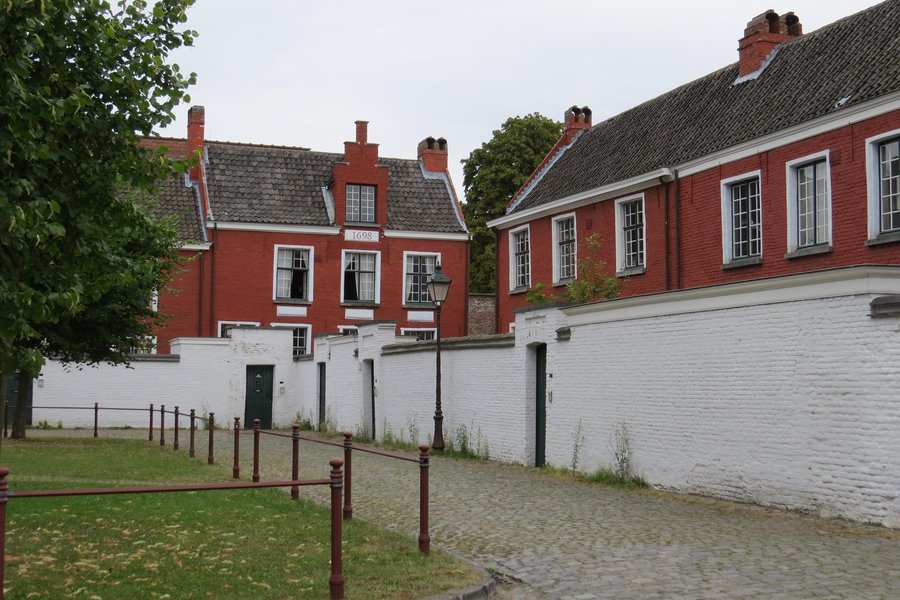
After visiting my sister-in-law in Antwerp, I requested a stop in Lierre on the way back. It was an easy half-hour drive from Antwerp through beautiful countryside, but I understand that the city is also easily-reachable via train, so it's easily combined with visits to Antwerp and/or Brussels.
Lierre is, on the old, a lovely, quiet little town with a main square maybe not as flashy as Brussels or Antwerp, but still very charming. The belfry on the Stadhuis is also WH as one of the 23 belfry-towers. There is a famous prisoner's gate and a small astronomical tower worth seeing as well, all close together. I also recommend getting some vlaaike, a baked delicacy specific to Liere that tasted a little like a tiny pumpkin pie.
The original main entrance to the beguinage is straight through the prisoner's gate, though there are a few other tiny side entrances to be found on the other sides. There was quite a bit of restoration work do, so it was all definitely a bit "dustier" than it otherwise is, but I still found the compact streets to be a lovely little walk, and admired the red-brick style architecture. I hope to be able to visit the others soon too, but definitely don't sleep on Lierre!
Keep reading 0 comments
One of the things I love about World Heritage Sites is how they can expose you to places, or in the case of the Flemish Béguinages, concepts, that I had not known before. History tends to be rather male-focused, and while I was aware women often had limited options in life in medieval times (with marriage or religious orders being some of the more common choices), I had never learned about the béguinages in northern Europe. These religious societies offered single women an option to live together in a community while retaining independence to come and go at will. When I visited the city of Bruges last August, I made sure to stop by the Begijnhof, tucked away in a quiet corner of the city. The béguinage is now home to Benedictine nuns, but the museum within the site shows the comfortable life a woman would have had living there, with her own kitchen and dining area (which could also be used for making handicrafts), bedroom, and an outdoor garden. The Begijnhof also has a rather nice church, where the women in residence would attend regular services. Although I didn't get to visit any other béguinages while in Belgium, the Begijnhof was a great introduction to a unique aspect of Flemish history.
Logistics: While one can view the exterior of the Begijnhof on any of the canal boat tours of Bruges, I highly recommend walking to this peaceful corner of the city.
Keep reading 0 comments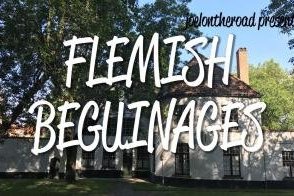
My wife and I visited the Beguinages of Leuwen and Bruges in August 2017. We chose these two as they seemed to be most representative of what Beguinages were really like. Of the two, I preferred the one in Leuwen as it really felt like a community still lived there. The one in Bruges was much more touristy and had a lot of folks wandering around.
See below for my full video review!
Keep reading 0 comments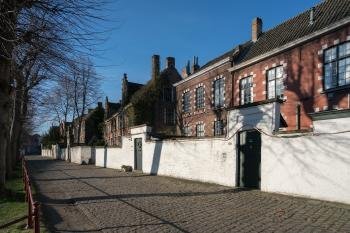
I visited 3 of the béguinages in January 2017.
The béguinages can be thought of as secular convents for women who were unmarried but didn't want to have to live with their families. They started during the crusades when there was a surplus of unmarried women due to so many men being sent off to war. Béguinages ceased their original purpose in the early 20th century.
Today they are just homes and properties where people live. Visiting them is very low key as the home are still in use. There are no formal visitor centers, and only a small amount of signage.
View my website to read more about the Flemish Beguinages.
Keep reading 0 comments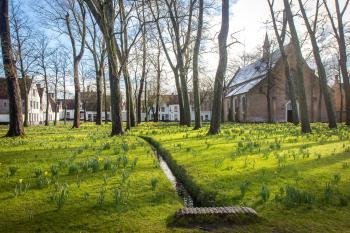
Honestly, I thought this (multi property) site would be a bit boring but I actually really enjoyed visiting a few of the places included in the listing. Not only do the beguinages have a really interesting history - they are actually quite photogenic!
There are 13 properties in the site and I don't feel like you need to see them all to get a good sense of the overall WHS. (Having said that, each is a bit different so you wouldn't get bored if you did want to visit every one of them.)
My favourite - and I would suggest not to miss it - is the Beguinage Bruges. The flowers and the trees in the central courtyard (see my photo) are really beautiful and it's a nice tranquil escape from the tourist crowds in the other parts of Bruges... mainly because there are signs telling people to keep their voices down! :)
If you're wondering which other beguinages to visit, I would suggest the one in Leuven, which is the biggest of them all. There are different streets you can walk down to see different elements of the complex and it's quite a different feel to the smaller ones.
I would also recommend heading to Ghent where there are two beguinages you can see. The older one in the city centre is much more picturesque, though.
As I said, I enjoyed see these more than I thought and, if you're travelling through Belgium …
Keep reading 0 comments
In the course of a long weekend in Flanders, I visited 6 béguinages in 5 cities - the one in Lier (quite nice, but nothing special), Ter Hoyen in Gent (large green space, rather idyllic, also known as the Small Béguinage), Sint Amandsberg in Gent (also known as Grand Béguinage, large area with a huge church), Ten Wijngaerde in Bruges (very pretty location next to a canal with many swans, today a Benedictine convent), the Grand Béguinage in Leuven (the nicest one of them, brick architecture on a large area, really a city within a city, today used for students of the local university), and the one in Mechelen (nothing special, the least impressive of them all). It is fun to walk through the pretty Flemish towns on the search for yet another béguinage, and once found, there is (almost) always a nice green space in the middle to relax for a while. They deserve their place on the WH list for their historic and architectural value, and for the insight into the unique life of the béguines, these "not-quite" nuns who temporarily chose to live in these secluded areas. There is also a very nice, and very similar, béguinage in the centre of Amsterdam - a possible extension?
Keep reading 0 comments
During my summer vacation in Brussels I visited several Beguinages.
The most beautiful for me was the one Leuven. It is large, full of red brick buildings, has several bridges over canals and lots of green. Together with the lovely town hall this was the peak of this truly charming city!
Bruges is also impressive. I loved the location close to the canals and the Minnewater as well as the large court with trees. The white paint of the houses and the unimpressive church spoiled the impression for me a little.
In Gent I visited all three Beguinages and was a bit confused: While it is clear that the Klein Begijnhof and St.Amandsberg have Unesco status there is some confusion about the Oude Begijnhof. In the (otherwise excellent) tourist information in the vismarkt I was told that all three are Unesco sites and there are official signs to it with the Unesco sign! Anyway, I walked there since it is close to the center. It is a nice place though there are no outer walls anymore and it is not well signed. I couldn't finde a map that would show which of the surrounding blocks were part of the beguinages.
To the south east from the center is the Klein Begijnhof, with is very nice though at the time they are doing some renovation work, but that is eventually a good thing. It isn't really that small and has several streets from different periods and an impressive church (I could …
Keep reading 0 comments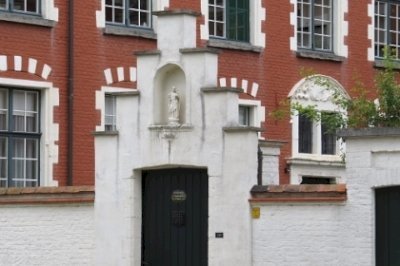
The béguinage I first visited (the one in Lier) was not in a very good state. Some parts of it seemed really rundown, although people did live in them.
The 'Groot Begijnhof' (there's also a smaller one) in Leuven however is a true haven of peace and quiet. Behind a modest gate, a well-preserved neighbourhood lies ahead.
On Sunday when I visited the site, many visitors - a lot of them foreign tourists - roamed the streets of this picturesque beguinage. There's a photo opportunity around every corner. Great place!
In 2013 I visited the Petit Beguinage of Gent. It is one out of the city's 3 that is incorporated within the WHS (the other is at St. Amandsberg). The beguinage lies a bit south of the center, conveniently close to Parking P3 South. It has several streets within enclosed walls, and access to the individual houses from these streets is blocked by a wall also. The small houses are now in private use, and even some cars have made it into the quiet zone.
Part of this beguinage is still being restored, although most of the houses are already blinking in red and white paint. There were a few other tourists around, and although it is a nice place for a stroll there's not a lot that reminds us of its former use.
Keep reading 0 comments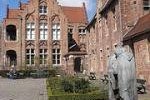
I agree with others who say that you can easily tick 2 WHS off your list when visiting belfries & beguinages. I have visited 6 out of the 13 inscribed sites and I think that Ghent and Leuven will give you a very good overview of what the beguinages' purpose was. Moreover, they are well kept and looked after.
Keep reading 0 comments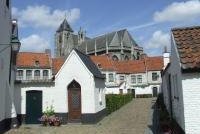
While seeking our belfries I also visited many of the Belgian beguinages:
Kortrijk - beguinage of St Elisabeth, a quiet and secluded courtyard
Ghent - Beguinage of the Virgin Mary, a large church
Ghent - St Amandsberg beguinage, secluded courtyard and gardens
Dendermonde - beguinage of St Alexius, large with a grassy courtyard
Bruges - large, peaceful, neat and tidy
Tongeren - untidy
Diest - pleasant garden with many statues
Leuven - large beguinage (small is not WHS), austere, serves as university staff accommodation
Mechlen - generally shabby, church is undergoing restoration
Turnhout - several grottoes and calvaries
Lier - untidy entrance, but neat garden beyond
Keep reading 0 comments
I have visited the following begijnhoven: Bruges - so pretty and calm with a lovely tree-filled green in the centre; Lier - lovely and one of the best with a real sense of the enclosed community of days gone past; Gent - there are three of them varying in attractiveness; Anderlecht (Brussels) - tiny and utterly charming; Leuven - rather formal and modernised as part of the KUL (University), but tell-tale signs of how it must once have looked naturally; Oudenaarde - small and not hugely memorable; Kortrijk - lovely with beautiful green and pretty chapel; Antwerp - pretty; Mechelen - not quite such an enclosed feel but still pretty. I love these places !!
Keep reading 0 comments
Since I live in Belgium and was born near Courtrai (French name of the city), I pass the Kortrijk (Dutch name) beguinage nearly daily.
It's not the most spectacular in Belgium but I like the quiet atmosphere.
So, please mention it in your list
Keep reading 0 comments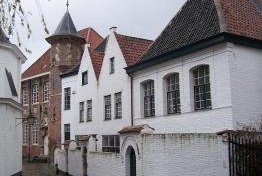
Having travelled pretty extensively in Flanders, I have managed to see quite a few Begijnhofs. The most impressive one I have seen so far is the Groot Begijnhof of Leuven. It is quite large and the quiet winding cobbled streets and redbrick houses are a lovely place to wander, especially if you are recovering from a long night in this superb cities student bars.
Whilst visiting friends in Gent I wandered around for a morning visiting the Begijnhofs there. Both of the inscribed areas were quiet refuges and displayed all the hallmarks associated with this style of urban planning. Sint-Amandsberg was a longish walk from the centre however it was very large and was the last example to be built. Walking around it was nice to see that it was still fully inhabited; there were lots of children being dropped off by their parents at one house which was decorated by balloons.
One of the most charming examples was in Kortrijk. This walled community is tucked just behind the main market square but it feels incredibly serene. In here there is a small museum dedicated to the lives of the beguines, and also one of the houses is now a guest house, offering perhaps the only opportunity for a short term stay for the casual tourist.
Even the Begijnhof in Brugge is calm in comparison to the rest of the tourist bustle of the city. This is where the real charm of the Begijnhofs lies; they are exceptionally well preserved …
Keep reading 0 comments
